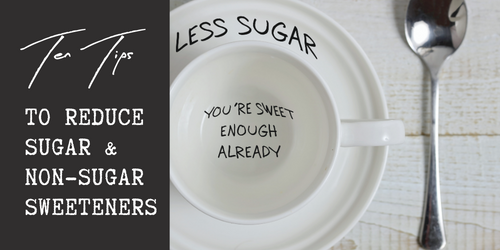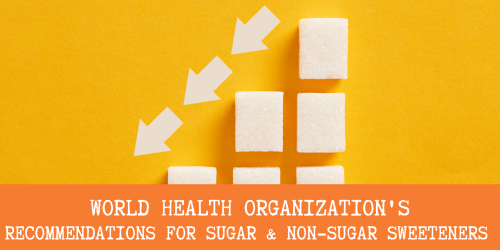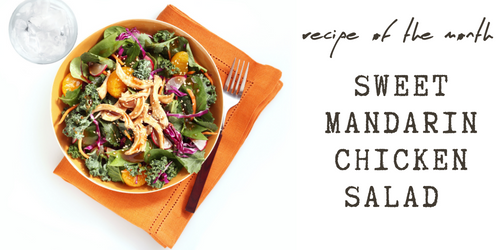In an era where processed foods, sugary beverages, and even "diet" food have become the norm in our diets, the World Health Organization (WHO) is taking a firm stand on the issue of the consumption of sugar and sugar alternatives. WHO has recently released a new guideline on non-sugar sweeteners (NSS), recommending against using them to control body weight. The recommendation is based on results from randomized trials that found that using non-sugar sweeteners had a "low" impact on reducing body weight compared with sugar and no change in intermediate markers of diabetes such as glucose and insulin. Results also suggest potential undesirable effects, such as increased risk of type 2 diabetes, cardiovascular disease, and mortality in adults, from long-term use of NSS. The science of nutrition is constantly evolving, and when new research emerges, it's my job to communicate and educate how this impacts you and your health. While I may have recommended using non-sugar sweeteners in the past, this new report gives more information to consider. In short, the research has found that replacing sugar with non-sugar sweeteners does not help in the long term, and therefore it's time to start reducing the overall sweetness in the diet altogether. This issue will help educate and inspire you to begin reducing the use of added sugar and non-sugar sweeteners. If you have additional questions or would like to schedule a consultation to discuss how this pertains to your health, please reach out!
-Stephanie
|
|
|
10 Tips to Reduce Sugar and Non-Sugar Sweeteners
|

- Become aware of added sugar and sugar substitutes you consume. Start by reading the labels of the products you buy and understanding how to identify sugar and non-sugar sweeteners.
- Other names for "sugar" include sucrose, refined sugar, brown sugar, corn sweetener, corn syrup, dextrose, evaporated cane juice, fructose, fructose syrup, fruit sweetener, glucose, glucose syrup, glucose-fructose syrup, high fructose corn syrup, lactose, malt sugar, maltose, molasses, maple syrups, raw sugar, sucrose, trehalose, and turbinado sugar. Honey, syrups, agave syrup, fruit juices, fruit juice concentrates, fruit nectar, fruit purees, and dried fruits are also sources of sugar.
- Low or no-calorie sugar substitutes and sweeteners include acesulfame K, aspartame, advantame, cyclamates, neotame, saccharin, sucralose, stevia, stevia derivatives, erythritol, and monk fruit.
- Retrain your tastebuds! The good news is you can retrain your tastebuds to reduce your dependence on sugar and non-sugar sweeteners. Start by gradually reducing the sugar or non-sugar sweeteners you add to your food and beverages. Over time, your taste buds will adapt to the lower sweetness level.
- Swap out sugary drinks for water or unsweetened beverages. Use more fresh fruit and herbs to add flavor and sweetness to your water. Replace sugary drinks and diet beverages with sparkling water, unsweetened tea, or black coffee.
- Experiment with your favorite recipes. While there is undoubtedly an art and science to baking, you can often reduce the amount of sugar by one-third without sacrificing flavor. You can also experiment with natural sweeteners like dates, honey, or maple syrup instead of refined sugar, which can help retrain your tastebuds and reduce the desired sweetness.
- Increase consumption of plants. Plant-based foods rich in fiber, protein, and fat will promote healthy blood sugar balance and can help reduce sugar cravings. Eating more fruits, vegetables, nuts, seeds, and whole grains, can provide natural sweetness and valuable nutrients. Incorporate more of these foods into your meals and snacks to satisfy your sweet cravings.
- Stop rewarding yourself (and children) with dessert, candy, or other sweets. It has become a cultural norm to reward good behavior and celebrate any win with a reason to indulge in a sweet treat. One of the most significant steps you can take to reduce dependence on sugar is to find other positive rewards.
- Embrace herbs and spices. Beware of traditional health foods such as whole grain cereal, oatmeal, and Greek yogurt with additional sweeteners. Instead, opt for plain varieties and add flavor with fresh fruit, herbs, and spices such as cinnamon, vanilla, or nutmeg.
- Enjoy fruit for dessert. Replace your traditional sweet tooth favorites with fresh fruit, such as candy, desserts, cakes, cookies, and pastries. Try cinnamon-baked apples, berries, or grilled peaches for an after-meal treat.
- Simmer down on the sauce. Added sugars are often present in sauces and condiments such as ketchup, BBQ sauce, tomato sauce, and salad dressings. Become aware of how frequently you consume these and start asking yourself, "Am I adding this for taste or out of habit?" and "Can I use less?" Small changes add up.
- Give it time. Remember that taste buds can adapt over time. It may take a few weeks for your taste buds to adjust to lower sugar levels. Be patient and persistent in your efforts to reduce sugar intake.
|
|
|
WHO’s Recommendations for Added Sugar Intake: Summarized
|

Excessive sugar consumption is linked with many health problems, including obesity, tooth decay, cardiovascular diseases, and type 2 diabetes. The WHO guidelines advocate for a significant reduction in the intake of added sugars, including added sugars and naturally occurring sugars in honey, syrups, and fruit juices. These guidelines emphasize the importance of curbing sugar intake to maintain a healthy weight, reduce the risk of chronic diseases, and promote overall well-being.
- The recommended daily sugar intake for adults and children is less than 10% of total energy intake, which is equivalent to 5 to 10 teaspoons of free sugar per day.
- The term "added sugars" is used here to refer to all sugars added to foods and beverages. It also includes sugars that occur naturally in honey, syrup, fruit juice concentrates, and fruit juices.
- For an average adult (with a calorie intake of 2,000 kcal), 10% energy is equivalent to no more than 50 grams of added sugar per day (about ten teaspoons or 14 sugar cubes).
- For children 1 to 3 years, 10% energy is about 30 grams of added sugar daily.
- For children 4 to 6 years, it is about 35 grams of added sugar per day.
- For children 7 to 10 years, it is about 42 grams of added sugar per day.
- In addition, WHO considers reducing added sugar intake to below 5% percent (i.e., no more than five teaspoons of sugar per day for adults) a reasonable long-term health policy goal.
- The WHO guideline does not refer to the natural sugars found in fresh fruit or milk, but only to added sugars of all types.
Non-Sugar Sweeteners:
- WHO recommends against the use of non-sugar sweeteners for controlling body weight or reducing risk of noncommunicable diseases. The recommendation applies to all people except individuals with pre-existing diabetes.
- This recommendation does not apply to personal care and hygiene products containing NSS, such as toothpaste, skin cream, and medications or to low-calorie sugars and sugar alcohols (polyols), which are sugars or sugar derivatives containing calories and are therefore not considered NSS.
|
|
Featured Recipe
Sweet Mandarin Salad
|

- 2 cups raw spinach
- 1 cup kale
- 1 cup shredded carrots
- 1 cup cooked chicken, diced
- 2 mandarin oranges, peeled
- 1/4 cup slivered almonds
- 1 avocado, sliced
- 1 tsp sesame seeds (optional)
Dressing:
- 1/4 cup rice wine vinegar
- 1 tablespoon of sesame oil
- 2 tablespoons of coconut aminos
- 2 tablespoons of olive oil
- 1 teaspoon of freshly grated ginger
- 1 clove of garlic minced
- salt and pepper to taste
Salad Directions:
- Combine spinach, kale, carrots, and cooked chicken in a large bowl. Toss well and add mandarins, almonds, and avocado.
- Sprinkle with sesame seeds, and enjoy! Pour dressing over salad just before serving.
Dressing Directions:
- In a small bowl, whisk together the dressing ingredients.
- Pour over the salad just before serving.
|
|
|
Be Inspired
|
|

|
|
|
About SO Nutrition
|
 Stephanie Leipprandt Ouellette, MBA, RDN, LD
Stephanie Leipprandt Ouellette, MBA, RDN, LD Stephanie has been working in the field of nutrition and dietetics since 1995. She earned a Bachelor of Science degree in Dietetics from Michigan State University, completed an Approved Pre-Professional Practice Program at Western Michigan University and earned a Master of Business Administration from Baker College. She’s been a Registered Dietitian Nutritionist since 1996 and licensed in Texas since 2007. In 2008, Stephanie earned her certification in Childhood and Adolescent Weight Management. Stephanie has extensive clinical & managerial experience, both in corporate settings and in the community. Now she wants to share her knowledge with you, because most (if not all) nutritional habits begin at home.
Stephanie and her family reside in Katy, Texas
|
|
| |
Copyright © 2023 Customized Nutrition Newsletters, All rights reserved.
|
|
| |
|
|